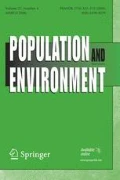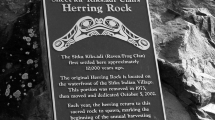Abstract
This case study examines the link between marine resource management, and the universal contraceptive use among married couples in the lobster-fishing village of Punta Allen, located in the Sian Ka’an Biosphere Reserve, Quintana Roo, Mexico. Several reasons appear to contribute to small desired and actual family sizes. Some of these include a medical clinic staff effective in promoting family planning, cooperative and private resource ownership, changing cultural attitudes, geographical limitations to population and economic growth, and a desire to conserve the environment for aesthetic and economic motives. Lastly, families desired to preserve a sustained balance between benefiting from lobster harvests today and safeguarding this marine resource for their children in the future.




Similar content being viewed by others
Notes
The enforcement of these regulations challenges the assumption of Hardin’s Tragedy of the Commons model that users of commonly held resources will not self-regulate absent state policy (Hardin 1968).
As is typical of ejidal systems, Punta Alleños do not own their land, they hold life-long use rights that can be transferred to sons. But land outside the town is privately owned—much of it by a few of the village’s founding families.
Population pressure frequently compromises conservation in Latin American Protected Areas. Donovan (1994) suggests that high rates of natural increase among locals has accelerated deforestation rates to approximately 5% per annum in Costa Rica’s Corcovado National Park. Wells and Brandon (1992) found that population growth exacerbated deforestation in core areas of the Mexican Monarch Butterfly Overwintering Reserves. Similarly, Herlihy (1985) documented how continued high fertility is straining the environment of Panama’s Chocó Indians.
For a more in-depth critique, see Thomas (1991).
Twelve is employed as the first year of childbearing potential since some girls under the age of 15 have been pregnant in Punta Allen, as is typical for rural areas in Mexico.
References
Agadjanian, V. (2001). Women’s work and fertility in a sub-Saharan urban setting: A social environment approach. Journal of Biosocial Science, 32(1), 17–35.
Bankole, A., Rodriguez G., & Westoff C. (1996). Mass media messages and reproductive behavior in Nigeria. Princeton, NJ: Princeton University, Office of Population Research.
Brown, L. R. (1997). Facing the prospect of food scarcity. In State of the world 1997 (pp. 23–41). New York: New York, W.W. Norton & Co.
Cain, M. (1984). On the relationship between landholding and fertility. New York: New York Center for Policy Study.
Caldwell, J. C. (1980). Mass Education as a determinant of the timing of fertility decline. Population and Development Review, 6(2), 225–255.
Caldwell, J. C., & Caldwell, P. (1987). The cultural context of high fertility in sub-Saharan Africa. Population and Development Review, 13(3), 409–437.
Carr, D. L. (2004). Proximate population factors and deforestation in tropical agricultural frontiers. Population and Environment, 25(6), 585–612.
Carr, D. L. (2005). Population, land use, and deforestation in the Sierra de Lacandón National Park, Petén, Guatemala. The Professional Geographer, 57(2), 157–168.
Carr, D. L., Pan, W. K., & Bilsborrow, R. E. (2006a). Declining fertility on the frontier: The Ecuadorian Amazon. Population and Environment, 28(1), 17–39.
Carr, D. L., Suter, L., & Barbieri, A. (2006b). Population links to Deforestation. Population and Environment, 27(1), 89–113.
Dachary, C., & Arnaiz Burns, S. M. (1989). Sian Ka’an: El Hombre y su Economía. Chetumal, Quintana Roo: CIQRO.
Dasgupta, P. S. (1995). Population, poverty, and the local environment. Scientific American, February, 40–45.
Davis, K. (1963). The theory of change and response in modern demographic history. Population Index, 29(4), 345–366.
De Jong, W., & Winsten, J. A. (1996). The use of the mass media to communicate public service messages: Lessons learned form past campaigns. Unpublished paper. Harvard School of Public Health.
De Sherbinin, A., Carr, D. L., Cassels, S., Jang, L. (2007). Population and natural resources. Annual Review of Environment and Resources, 32(5), 1–29.
Demeny, P. (1992). Policies seeking a reduction of high fertility: A case for the demand side. Population and Development Review, 18(2), 321.
Donovan, R. (1994). BOSCOSA: Forest conservation and management through local institutes (Costa Rica). In D. Western, R. M. Wright, & S. C. Strum (Eds.), Natural connections: Perspectives in community-based conservation and management (pp. 215–233). Washington, DC: Island Press.
Doveri, A. (2000). Land, fertility, and family: A selected review of the literature in historical demography. Genus, LVI(3–4), 19–59.
Easterlin, R. A. (1978). The economics and sociology of fertility: A synthesis. In C. Tilly (Ed.), Historical studies of changing fertility (pp. 57–133). Princeton, NJ: Princeton University Press.
Easterlin, R. A. & Crimmins, E. M. (1982). An exploratory study of the “Synthesis Framework” of fertility determination with World Fertility Survey Data. Voorburg, The Netherlands: International Statistical Institute, World Fertility Survey Scientific Report.
Ehrlich, P. (1968). The population bomb. New York: Ballantine Books.
Fearnside, P. M. (2001). Land-tenure issues as factors in environmental destruction in Brazilian Amazonia: The case of Southern Pará. World Development, 29(8), 1361–1372.
Freedman, R. (1997). Do family planning programs affect fertility preferences: A literature review. Studies in Family Planning, 28(1), 1–13.
Good, M. D. (1980). Social status and fertility: A study of a town and three villages in North Western Iran. Population Studies, 34, 317.
Hardin, G. (1968). The tragedy of the commons. Science, 162, 1243–1248.
Hawley, A. H. (1955). Rural fertility in central Luzon. American Sociological Review, 20, 21–27.
Herlihy, P. H. (1985). Settlement and subsistence change among the Chocó Indians of the Darién Province, Eastern Panamá. Yearbook, Conference of Latin American Geographers, 11, 11–16.
Instituto Nacional de Estadística. (1992). Quintana Roo: Pérfil Sociodemográfico: XI Censo General de Población y Vivienda, 1990. Aguascalientes, Mexico: INEGI.
INEGI (Instituto Nacional de Geografia e Informatica) (2001). Cuaderno Estadístico Municipal: Edición 2000. Aguascalientes, Ags.: Instituto Nacional de Estadística, Geografía e Informática.
Instituto Nacional de Estadística. (2002). Quintana Roo: Pérfil Sociodemográfico: XII Censo General de Población y Vivienda, 2000. Aguascalientes, Mexico: INEGI.
Instituto Nacional de Estadística. (1993). Cozumel, Estado de Quintana Roo: Cuaderno Estadistico Municipal.
Knodel, J., Chamratrithirong, A., et al. (1987). Thailand’s reproductive revolution: Rapid fertility decline in a third-world setting. Madison: University of Wisconsin Press.
Leal, D. R. (1998). Community-run fisheries: Avoiding the “tragedy of the commons”. Population and Environment, 19(3), 225–243.
Leslie, K. (1995). Folk Management and the Campo System: Private Sea Ownership in a Mexican Lobster Cooperative. M.A. thesis, Department of Anthropology. DeKalb, IL, Northern Illinois University.
Leslie, K. (1996). “Tragedy” in a privatized commons? Success and wealth in a Mexican lobster cooperative. San Francisco: Conference of the American Anthropological Association.
Lesthaeghe, R., & Surkyn, J. (1988). Cultural dynamics and economic theories of fertility change. Population and Development Review, 14(1), 1–43.
Miller, D. L. (1989). The evolution of Mexico’s spiny lobster fishery. In F. Berkes (Ed.), Common property resources: Ecology and community-based sustainable development. London: Belhaven Press.
Ostrom, E. (1990). Governing the commons: The evolution of institutions for collective action. New York: Cambridge University.
Perspectivasestadísticas de Quintana Roo, México, INEGI, 1997.
Piotrow, P. T., Treiman, K. A., Rioman II, S. H. Y. J. G., & Lozare, B. V. (1994). Strategies for family planning promotion. World Bank Technical Paper (ISSN 0253-7494, Number 223).
Price, M. D. (1987). Cooperatives and development: The Lobster Fishermen of Belize. In Yearbook, Conference of Latin American Geographers.
Ross, J. A., & Mauldin, P. W. (1996). Family planning programs: Efforts and results, 1972–1994. Studies in Family Planning, 27(3), 137–147.
Singh, K. P. (1986). Correlates of fertility behaviour: A study of rural communities in Punjab and Haryana. New Delhi: Concept Publishers.
Singh, R. D. (1994). Fertility-mortality variations across LDCs: Women’s education, labor force participation, and contraceptive-use. KYKLOS, 47(2), 2, 209–229.
Tuladhar, J. M., et al. (1982). Differential Fertility in Rural Nepal. Population Studies, 36(1), 85.
United Nations. (1987). Fertility behavior in the context of development: Evidence from the world fertility survey. New York: UN.
VanWey, L. K., D’Antona, Á. O., & Brondízio, E. S. (2007). Household demographic change and land use/land cover change in the Brazilian Amazon. Population & Environment, 28(3), 163–185.
Westoff, C. F., Rodriguez, G., & Bankole, A. (1996). Family planning and mass media messages. Princeton, NJ: Office of Population Research, Princeton University.
Wells, M., & Brandon K. (1992). People and parks: Linking protected management with local communities. Washington, DC: The World Bank.
Young, E. (1999). Local people and conservation in el Vizcaino Biosphere reserve. Geographical Review, 89(3), 364–389.
Acknowledgments
I would like to express my gratitude to the Tinker and Mellon Foundations and the University of North Carolina (UNC) Institute of Latin American Studies for supporting this research. I sincerely thank my informants for giving their time for interviews, and to the entire community of Punta Allen for their genuine warmth, honesty, and trust. The NGO Amigos de Sian Ka’an deserves mention as well for supporting my research in the Punta Allen. I would also like to extend my profoundest gratitude to colleagues at the Carolina Population Center and UNC Department of Geography, particularly Tom Whitmore for his insightful and detailed comments on prior drafts of this manuscript.
Author information
Authors and Affiliations
Corresponding author
Rights and permissions
About this article
Cite this article
Carr, D.L. Resource management and fertility in Mexico’s Sian Ka’an Biosphere Reserve: Campos, cash, and contraception in the lobster-fishing village of Punta Allen. Popul Environ 29, 83–101 (2007). https://doi.org/10.1007/s11111-008-0062-0
Published:
Issue Date:
DOI: https://doi.org/10.1007/s11111-008-0062-0




